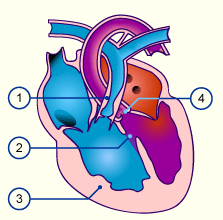Question:
My son had Cyanotic complex congenital heart defect he only survived ten days now im wondering what exactly was formed wrong with his heart?
Answer:
Hi Tanesha,
I am so sorry about your loss. Although much can be done, some heart defects are just to complex to be fixable.
Let me explain first how the circulation works:
Normally, O2 poor (“Venous”) blood from the right side of your heart goes to the lungs where CO2 is removed and replaced with O2. This is called the ‘Pulmonary” circulation. It then returns to the left side of your heart where the now O2 rich (“Arterial”) blood is pumped to the rest of your body to supply it with Oxygen. This is called the “Systemic” circulation. When that is done, your blood is now again O2 poor and thus venous, and returns to your heart to start this cycle anew.
In other words, blood first makes its way through the systemic circulation, then the pulmonary circulation, then back to the systemic circulation, and so on.

This is what a normal circulation looks like before birth (click on the image):
This is what it looks like after you are born and your Umbilical cord is cut (click on the image):
In cardiac abnormalities with a right to left shunts, oxygen-poor blood gets from the right half of the heart into the left side and thus into the systemic circulatory system, without first going through the lung circulation. This can occur through an opening between the division (“Septum”) that divides the left and the right side of your heart in combination with some type of obstruction to the circulation to the lung. Right-to-Left shunts occur when the blood pressure in the Right side of your heart is higher than the left side, just the opposite of what it is supposed to be.
A right-to-left shunt occurs when:
- there is an opening or passage between the atria, ventricles, and/or great vessels; and,
- right heart pressure is higher than left heart pressure and/or the shunt has a one-way valvular opening.
Besides medications, treatment may include surgery to close the opening and remove the obstructions. Sometimes emergency surgery is needed even in premature infants.
Tetralogy of Fallot is the most common disorder (although still rare) It is a very serious condition, but usually fixable with an operation. The right side of the heart has the O2 poor blue blood, the purple color shows abnormal mixing of O2 rich blood . In normal situations, there would be no purple, only O2 poor blue (venous) and O2 rich red (arterial) blood.
- Pulmonary stenosis
- Ventricle septum defect
- Hypertrophy of the right ventricle
- Aorta riding over the septum defect
There are other, even more complex conditions that may cause desperate situations, where an infant cannot survive without a major heart operation. Some of these congenital abnormalities are also associated with defects elsewhere in the body. It may have been that combination of heart and other problems that did not make it possible for your baby to survive.
Hope this helps,
Dr T



